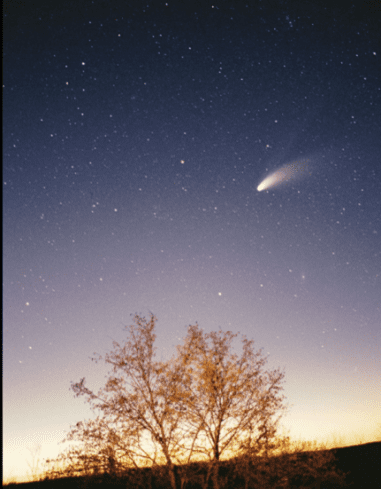Comets are mysterious entities that arise from two different areas of our solar system: the Kuiper Belt and the Oort cloud.
Kuiper Belt (KB)
Similar to the more well-known asteroid belt between Mars and Jupiter, the Kuiper Belt contains leftovers from the formation of the solar system. Located just beyond Neptune, the KB contains an estimated trillion fragments of ice, rock, and frozen gases. Ranging in size from dust particles to greater than 100 kms in size, former planet Pluto is the largest known KB resident with a diameter of 2,376 kms.

Neptune’s gravitational field will occasionally propel a KB object into an elongated orbit toward the Sun. As it approaches, the comet’s surface begins to vaporize, spewing a glowing tail of dust and gases that can extend for millions of kilometers. KB comets are called short-period comets as they have orbits of less than 200 years. Halley’s Comet is the KB’s most famous comet, returning every 76 years. It is the only known short-period comet that is visible to the naked eye and will return in 2061.
Oort Cloud (OC)
The Oort cloud lies far beyond Neptune, on the very edge of our solar system. Long-period comets originate from here; meaning they take more than 200 years to orbit the Sun. Comet Hale-Bop was one of the most spectacular comets of the 20th century. Visible to the naked eye for 18 months in 1997, it was four times larger and 1,000 times brighter than Halley’s Comet. It is not predicted to return for 2,400 years.
Nothing lasts forever, and neither do comets. Eventually, after many flybys of the Sun, all the ice and volatile gases have boiled away, leaving nothing behind but a rocky remnant.











